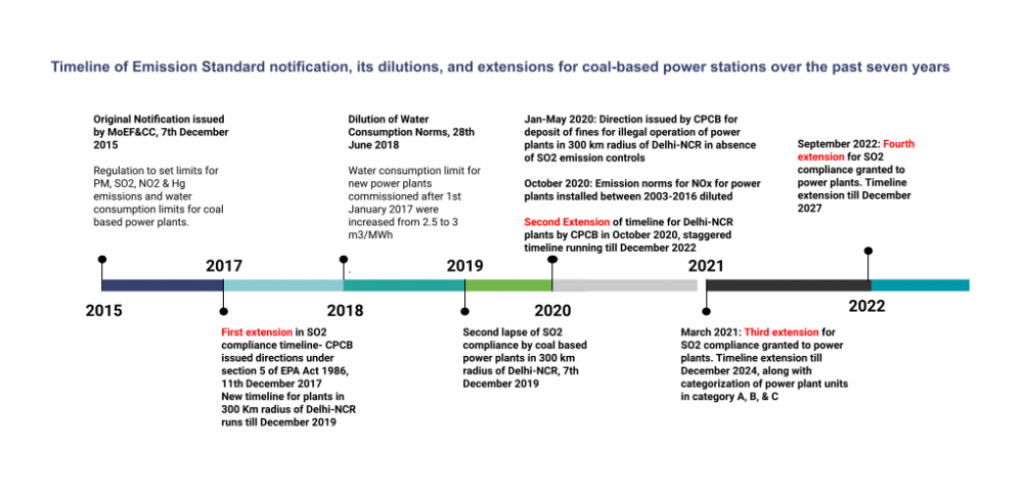Biodiversity & Environment
India's Coal Plants: SO2 Emission Control
- 14 Dec 2023
- 8 min read
For Prelims: Centre for Research on Energy and Clean Air (CREA), Sulfur Dioxide (SO2), Flue Gas Desulfurization (FGD), Circulating Fluidised Bed Combustion (CFBC), Greenpeace, Coal, Oil, Natural Gas
For Mains: The Environmental Consequences of Measures to Mitigate SO2 Emissions
Why in News?
Recently, an analysis by the Centre for Research on Energy and Clean Air (CREA) has found less than 8% of India’s coal-based power plants have installed the SO2 emission reduction technology recommended by the Union Ministry of Environment, Forest and Climate Change (MoEF&CC) to keep Sulfur Dioxide (SO2) emissions in check.
- According to a 2019 Greenpeace study, India is the largest emitter of SO2 in the world.
What are the Technologies to Reduce SO2 Emissions?
- Flue Gas Desulfurization (FGD):
- FGD is the process of removing sulphur compounds from the exhaust emissions of fossil-fueled power stations.
- This is done through the addition of absorbents, which can remove up to 95% of the sulphur dioxide from the flue gas.
- Flue gas is the material emitted when fossil fuels such as coal, oil, natural gas, or wood are burned for heat or power.
- Circulating Fluidized Bed Combustion (CFBC):
- CFBC Boiler is an environment-friendly power facility to reduce the discharge of pollutants such as nitrogen oxide and sulphur oxide by injecting air and lime at the same time for burning.
- A bed of solid particles is said to be fluidized when the pressurised fluid (liquid or gas) is passed through the medium and causes the solid particles to behave like a fluid under certain conditions. Fluidization causes the transformation of the state of solid particles from static to dynamic.
What are the Key Findings of the Study?
- Only a combined capacity of 16.5 Gigawatts(GW) of coal plants have installed FGDs and Circulating Fluidised Bed Combustion (CFBC) boilers equivalent to 5.9 GW across India.
- The CREA analysis found that 92 % of the country’s coal power plants function without FGDs.
- Blanket extension of the deadline for all coal power plants without checking on their progress by MoEF&CC and Central Pollution Control Board (CPCB) played a major role in derailment of emission controls from coal-based electricity generation units.
- The MoEF&CC introduced emission standards in 2015 for regulating PM, SO2, NOx, and Hg (Mercury) emissions.
- The deadline has been extended four times for units in Delhi and the National Capital Region (NCR) and three times for most other units across the country.
- India’s energy generation installed capacity stands at 425 GW. The thermal sector holds a predominant position within the overall installed capacity, encompassing coal (48.6%), gas (5.9%), lignite (1.6%) and a minimal share (<0.2%) from diesel.
What is the Categorisation of Power Plants for Installing FGD?
- In 2021, the MoEF&CC divided the categories of coal-power plants based on geography to enforce deadlines.
- Category A is demarcated to coal-based power plants within a 10-kilometer radius of the National Capital Region (NCR) and of cities with a million-plus population.
- Category B is within a 10 km radius of critically polluted areas or non-attainment cities.
- Category C is the remaining plants throughout the country.
- The majority of the country’s power plants belong to Category C, with the longest deadlines.
Centre for Research on Energy and Clean Air (CREA)
- CREA is an independent research organisation focused on revealing the trends, causes, and health impacts, as well as the solutions to air pollution.
- It uses scientific data, research and evidence to support the efforts of governments, companies and campaigning organisations worldwide in their efforts to move towards clean energy and clean air.
Way Forward
- Accelerate FGD Implementation:
- Prioritise and expedite the installation of FGD technology in coal-based power plants. Encourage and incentivize the adoption of this technology to ensure compliance with emission standards set by the MoEF&CC.
- Expand CFBC Implementation:
- Provide support and incentives for power plants to adopt CFBC technology, aiming for a broader implementation to enhance environmental sustainability.
- Stricter Enforcement and Monitoring:
- Strengthen regulatory mechanisms for monitoring and enforcing emission standards. Implement strict penalties for non-compliance with deadlines and emission regulations.
- Research and Development (R&D):
- Invest in research and development to explore and implement advanced technologies that go beyond current standards. Foster innovation in clean energy solutions and emission control technologies to make coal-based power generation more sustainable.
UPSC Civil Services Examination Previous Year Question (PYQ)
Prelims
Q1. Why is there a concern about copper smelting plants?
- They may release lethal quantities of carbon monoxide into environment.
- The copper slag can cause the leaching of some heavy metals into environment.
- They may release sulphur dioxide as a pollutant.
Select the correct answer using the code given below.
(a) 1 and 2 only
(b) 2 and 3 only
(c) 1 and 3 only
(d) 1, 2 and 3
Ans: (b)
Q2. With reference to furnace oil, consider the following statements:
- It is a product of oil refineries.
- Some industries use it to generate power.
- Its use causes sulphur emissions into the environment.
Which of the statements given above are correct?
(a) 1 and 2 only
(b) 2 and 3 only
(c) 1 and 3 only
(d) 1, 2 and 3
Ans: (d)
Mains
Q1. Describe the key points of the revised Global Air Quality Guidelines (AQGs) recently released by the World Health Organisation (WHO). How are these different from its last update in 2005? What changes in India’s National Clean Air Programme are required to achieve revised standards? (2021)
Q2. Environmental Impact Assessment studies are increasingly undertaken before a project is cleared by the Government. Discuss the environmental impacts of coal-fired thermal plants located at coal pitheads. (2014)





